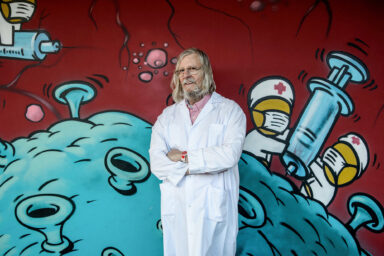Over a million people in the US have left the workforce due to lingering effects of the coronavirus, and millions of others still suffer symptoms daily, according to a new report.
“They don’t know what to do with me.”
Linda Hurst was referring to the doctors she has seen to find relief from the illness she has struggled with daily, almost two years after testing positive for COVID-19. “It put me down,” she said.
Hurst lives in rural Kentwood, LA, and was diagnosed with COVID-19 in June 2020. A year and eight months later, Hurst says she is exhausted and in pain every day, and sleeps “all the time” to escape it. Her doctors have no answers, and one she went to for help flatly told her, “I don’t believe you.” Another prescribed the anti-malarial drug hydroxychloroquine. She took it.
Hurst, who is in her 60s, said she was an active woman who bicycled, bowled, and played golf before she got sick. Today, she needs two days to recuperate from her weekly grocery shopping and errand run. She and her husband, Ken, live in a remote area of the state that is “an hour’s drive from anything.” Her husband shoulders the brunt of household work.
How does she cope? “Sleep gets me though,” she said. “I don’t feel the pain.”
Hurst has been on steroids almost continuously since she became ill. She is now on a low dose and faces more tests and treatments for the advanced kidney failure and liver disease doctors recently diagnosed. She also developed lupus, which her doctors think may have been brought on by COVID-19. Hurst said she is thinking of traveling out of state to a world-renowned medical center for care. “My journey is not over,” she added firmly.
Hurst is one of millions of Americans struggling with the life-altering symptoms of long COVID, which the Centers for Disease Control and Prevention (CDC) defines as new, returning, or ongoing symptoms four or more weeks after an initial infection with the virus. Chronic fatigue is common; it is estimated that the condition has forced a million people to drop out of the workforce, the US Government Accountability Office (GAO) reports. US studies have found that an estimated 10 percent to 30 percent of coronavirus survivors develop long COVID.
While the federal government is taking steps to help people who have the disease and pay for research, the causes, the full scope, and effective treatments for long COVID are unknown. Some, including Hurst, say they get help and support from online groups created by and for people who have the disease.

Symptoms of the disease — also called post-acute COVID, post-COVID conditions, and chronic COVID — vary from patient to patient, according to GAO, which analyzed CDC data on the disease. Ongoing changes in or loss of taste or smell have often been discussed, but this appears to be just the tip of the iceberg for people with long COVID.
Even as the number of cases in the US drops and COVID-19 rules are relaxed or removed, patients with long COVID continue to experience cognitive impairment (“brain fog”), shortness of breath, muscle or joint pain, heart palpitations, problems sleeping, and changes in mood along with debilitating, relentless fatigue. The disease can affect organ systems, including the heart, lungs, and kidneys, and cause tissue damage, GAO said.
For some, including Hurst, the severity of the symptoms shifts without warning, and she doesn’t know how she will feel when she opens her eyes any given morning.
Post-viral syndromes are well documented for a range of infections, according to GAO; one study found that 27 percent of SARS (Severe Acute Respiratory Syndrome) patients still had chronic fatigue four years after they first fell ill. And debilitating as this can be, for some, it just scratches the surface: Patients also suffer from rashes, pain, and shortness of breath, and others, like Hurst, have an elevated risk of heart or kidney failure.
There can be serious mental effects as well. One study that reviewed the electronic health records of more than 200,000 COVID-19 survivors found that within six months of their initial infection, one-third of patients experienced neurological or psychological symptoms such as depression, anxiety, post-traumatic stress disorder, and psychosis, according to GAO.
Long COVID can cause dramatic life changes. While some people with the illness have to cut down their work hours — GAO reported that one study of 4,000 patients found this was true for 45 percent of patients — some have to stop working entirely due to fatigue or cognitive issues. In some cases, the changes in patients’ work life affect their medical insurance coverage, complicating or curtailing their options for and ability to access health care.
The list of unknowns surpasses knowledge to date, GAO reports; the risk factors, causes, and effects of long COVID are not completely understood. However, risk factors include preexisting conditions, such as Type 2 diabetes, as well as the severity of the patient’s COVID-19 infection. The effects, if any, of COVID-19 vaccinations are not yet clear.
Researchers point to a number of possible causes for long COVID and theorize that they may vary from patient to patient. One theory is that, for some, COVID-19 triggers an autoimmune response, causing the person’s immune system to attack its own antibodies. Other theories, according to GAO, are that the virus remains in the body, causing the symptoms; that COVID-related organ damage leads to symptoms; or that persistent microclots block blood flow. There is also the possibility that the virus may disrupt the immune system and reactivate viruses the patient had previously contracted, such as Epstein-Barr, researchers say.
GAO reports that researchers are working to come up with ways to reliably diagnose and treat long COVID. Treatment plans are based on patients’ symptoms and may include anti-inflammatory medication and steroids. New therapies are now in trials to find effective new treatments for long COVID patients, according to GAO. Some patients may qualify for Social Security Disability Insurance.
The CDC has contracted for a study in which patients can volunteer to share health information via a cloud-based platform, and provided guidance for health care providers as well as the public.
Challenges to fighting long COVID include the necessity for solid, wide-ranging research, diagnosis, and treatment, as well as its economic repercussions, GAO reports.
Hurst thinks there should be specialists in the disease that she could more easily access, as well as patient advocates to help negotiate with insurance companies. Meanwhile, Hurst continues her battle with the relentless illness known as long COVID.
“I’m a fighter,” she said. “I’d be dead otherwise.”



